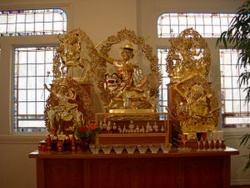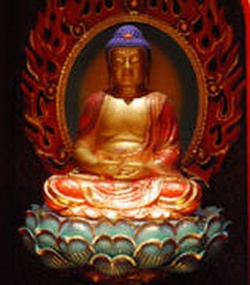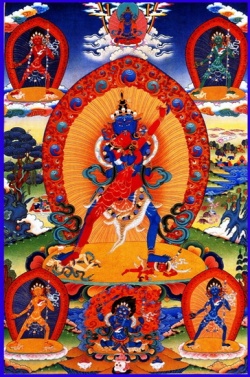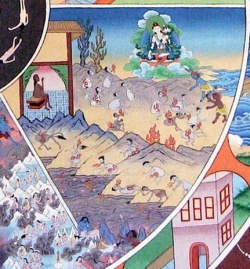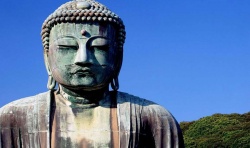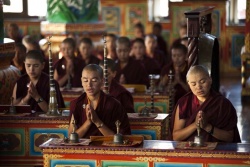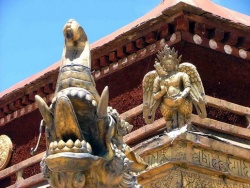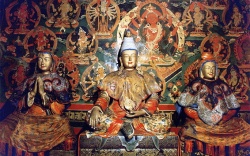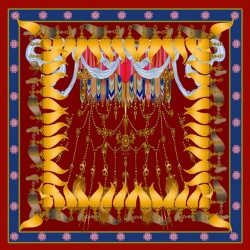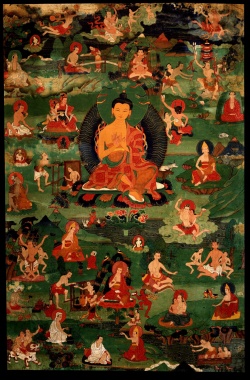The Practice of Insight Meditation
Robert Brumet May 19, 2008
This article was written in May 2008 and was later published in Unity Magazine. It provides a brief description of the theory and practice of Insight Meditation.
An inner shift was taking place deep inside of me. One aspect of that shift was that I could no longer separate my spiritual practice from my everyday life.
I had been practicing meditation for several years but it felt like it was an add-on to my life rather than a central part of it, which it now needed to be. In the summer of 1988 I found what I was looking for.
Shinzen Young is a former Zen monk who began to teach a practice traditionally known as vipassana- more commonly known in the West as insight meditation.
He had done some work with the Menninger Foundation near Topeka Kansas and subsequently began teaching meditation retreats in Topeka. I discovered him via a friend of mine.
As I sat in front of this man with great curiosity, the first words I heard him speak were “Vipassana is intended to be employed every moment of one’s life.
No experience is outside of the practice.” He had my attention.
Over the next twenty years I attended over seventy-five meditation retreats, received instruction from more than twenty teachers and completed a two and a half year training program qualifying me to lead my own retreats.
I have now been teaching insight meditation for fifteen years and have been leading retreats for over ten years.
And yet I am still a beginner. There are no experts in this practice. Each moment is brand-new and unique. There is no finish line.
The intention of this meditation practice- its long-term effect if practiced diligently- is to achieve a peace of mind that cannot be disturbed by any event or circumstance in one’s life. How is this possible? Let’s first examine the nature of the practice and then we will look at how it works.
The Meditation Practice
We will start with the two key elements. The first element is that of awareness.
This means being continuously aware of one’s experience in every moment.
In other words: we are aware and we know that we are aware.
Each moment we each have a variety of internal experiences- thinking, feeling, sensing, judging, etc.
We pay close attention to these experiences. And much of the time we are also engaged in some external activity- walking, talking, eating, driving, etc. We pay attention to this as well.
Usually our awareness is filtered through our thoughts, judgments and memory associations.
Almost everything we see or hear immediately conjures up a whole parade of memories, thoughts and judgments. (Some experts tell us that when we meet someone for the first time it takes about four seconds for us to formulate an opinion of this person!)
We don’t see things as they are as much as we see them as we are.
In this meditation practice we cultivate something called bare attention.
This means being aware of what is, apart from our thoughts and opinions about what is.
We practice distinguishing what we experience directly from the meaning that we give to the experience.
Nothing is seen as inherently good, bad, right, or wrong- it is just what’s here.
We can , and will, have preferences (likes and dislikes) but we learn to separate these from the primary experience itself.
We practice this bare attention as continuously and precisely as we are able.
And we are always practicing. We are not setting continuous awareness as a goal to be achieved, but rather an intention to apply in each moment.
The second key element of this practice is that of acceptance.
This means acceptance of our internal experiences- our thoughts, feelings, sensations, etc.
It means opening to and allowing each experience to arise within us without clinging to any of it and without resisting any of it. We allow our inner experiences to unfold naturally and spontaneously without any resistance to any of it.
As physical beings we have a strong tendency to resist that which is painful and to cling to that which is pleasurable.
This meditation practice is like swimming upstream in the sense that we are letting go of some very deep habits of mind.
Practicing acceptance means that we recognize our clinging and resistance and release it, if we can.
And if we can’t let it go then we accept the resistance itself as part of what is here. We don’t see clinging or resistance as being bad but simply as our habituated response to life as it unfolds.
Regarding our external experiences: we simply live our life in as compassionate and responsible way as we can.
A primary rule in regard to our external life is simply to do no harm. Our external life is certainly important, but if our intention is to find peace of mind then our work begins internally.
The best way to transform our outer world is to first focus upon our inner world.
Now, all of this is very difficult to immediately implement in the midst of our daily life. So we begin with the practice of sitting quietly for a period of time.
In this quiet time we may focus on one small aspect of our experience- such as a body sensation- and work with awareness and acceptance of that small piece of our reality.
If we attend a meditation retreat where we can engage the practice for several consecutive days then we gradually deepen and broaden our practice to include other experiences in our life. Over time we begin to integrate more and more of this practice into our everyday life.
At a meditation retreat one typically remains silent for several days doing alternate sitting and walking meditations.
The day is spent observing the experiences of the body and the mind as if one were a scientist observing a specimen under a microscope. But with this practice we are both the scientist and the specimen! We are both the observer and the observed.
A meditation retreat provides the opportunity to both deepen and broaden our practice.
We deepen it by exploring the constantly changing experiences of the body-mind ever-more clearly and precisely. We broaden our practice by seeing that indeed ‘no personal experience is outside the realm of this practice.”
How It Works
According to tradition, this practice began with the enlightenment of Siddhartha Gautama -historically known as the Buddha- about 2500 years ago.
In his spiritual awakening he saw clearly and deeply into the nature of human suffering- its cause and its cure.* He then spent the rest of his life sharing this wisdom with others.
By virtue of this insight the Buddha clearly saw three causes of human suffering.
They are typically named craving, aversion and delusion. All three of these are activities of the mind, which means that suffering is caused by the mind- not by external conditions.
(External conditions can certainly cause pain or discomfort, but suffering itself is a product of the mind.)
Aversion– sometimes called resistance- refers to the tendency of the mind to push away, or attempt to escape from, any experience that is unpleasant. The body will tense up in response to anything unpleasant- or anticipated to be unpleasant.
The mind tends to respond to unpleasantness with fear, anger, or judgment.
All of these are forms of aversion.
Pleasure and pain and are of the body- happiness and suffering are of the mind.
When we see, clearly and deeply, that suffering is caused by resistance to pain and attachment to pleasure then we will eventually become free from our suffering.
When we experience the direct connection between attachment, resistance and suffering then we quite naturally release these causes of suffering.
When we realize that we can experience pain without suffering and that pleasure does not equal happiness, we begin to live our life free from attachment to the capricious fortunes of the world.
Our external circumstances can cause pleasure or pain in the body.
Delusion is the tendency of the mind to equate pain with suffering and pleasure with happiness.
Our delusion leads us to believe that the cause of our suffering is external and beyond our control.
Delusion keeps us unconsciously projecting the cause of our suffering onto our external world rather than seeing that suffering itself is caused by the mind.
Since we perceive our suffering as having external causation we will have a strong tendency to look externally for the relief from our suffering.
This is the root of all addictive behavior.
The practice of insight meditation- practicing bare attention, continuously with a complete acceptance of each internal experience, will dissolve the causes of suffering.
Awareness, bare attention, dissolves delusion -the tendency to project the cause and the cure of our suffering onto external factors- and discerns the true cause of our suffering.
Acceptance, nonresistance dissolves the tendency to cling to or resist our experiences.
We learn that suffering is not the same as pain or discomfort. In the practice of insight meditation we begin to see deeply into the cause of our own suffering and seeing that- even briefly- we begin to unravel the mechanism that perpetuates our suffering.
Continued practice helps us to anchor and integrate these insights into our everyday life.
Frequently Asked Questions
Below are some typical questions that arise from retreat participants, followed by what might be my typical response to that question.
Q. Should we really accept all of our experiences? Should we not affirm the positive ones and deny the negative?
A. First, we are talking about accepting only our subjective, internal experiences.
It may be necessary to change an external life condition and it is certainly okay to do so if the result does not harm anyone.
Secondly, accepting an internal condition does not mean clinging to it. We accept each experience in the present moment and remain open to the next experience which arises.
As we become aware of and accepting of each experience that arises we begin to see that some experiences include suffering and some do not. Some experiences are called “negative” because they include suffering.
Bare attention allows us to see the cause of that suffering.
We can see that it is not the experience itself that creates suffering but rather it is our internal response to that experience which will determine whether or not we suffering.
With that insight one quite naturally begins to let go of the craving or the resistance which creates the suffering. When suffering is dissolved then so is that which we call negativity.
This will occur naturally without the need to mentally judge any of our experiences as positive or negative.
(These judgments themselves arise from our conditioning and will perpetuate our suffering if we take them as truth.)
Q. Isn’t suffering necessary? I have personally grown a great deal from my suffering.
A. Yes, suffering can teach us a great deal if we pay attention to it and are open to the potential wisdom within it.
The irony is that the very same method we employ to learn from our suffering – awareness and acceptance- is the same method that tends to dissolve our suffering. One thing we will learn from our suffering is that it is no longer necessary!
Q. But isn’t suffering necessary to motivate us? Hasn’t civilization progressed because of our desire to avoid suffering?
A. It is important to distinguish between pain and suffering. Overcoming pain does not guarantee freedom from suffering. Scientific technology has helped us overcome much of the pain and discomfort once experienced by humans but it is questionable as to whether or not the progress of technology has led to less overall human suffering.
If we are motivated solely by an attempt to avoid suffering then we will simply create more suffering, or at best, we only change the form of our suffering. Today’s solutions become tomorrow’s problems.
When we live free from suffering we are no longer motivated by the ego-centric posture of self-protection and self-aggrandizement. (These are the products of a deluded attempt to escape from suffering.)
Instead, we are motivated by the compassion and wisdom of our essential nature. This essential nature knows that it is not separated from others or from the world we live in.
Our motivation for action is intrinsically related to the highest good for everyone because we see there is no difference between self-interest and the well-being of others. I see this as true progress.
Q. You called this a spiritual practice yet I do not hear you use any language that seems spiritual or religious. Where is God in all of this?
A. Since this system originates in Buddhist philosophy it reflects a particular characteristic of the Buddha’s teaching, which is a deliberate avoidance of overtly religious or theological concepts and language.
This teaching is directed toward each individual’s discovery of truth within his/her own personal experience, thereby making it real and not just theoretical.
He saw that religious systems may be comforting but at some point they can also be an impediment to a person’s direct realization of truth. Theology or religion may be helpful to many of us but it is very important not to confuse the maps with the journey itself.
In Unity, we teach that God is present everywhere and in every moment.
The only thing that seems to separate us from God is the mind’s delusion of separation. To be free from suffering is to be free from the illusion of separation.
This practice can overcome that illusion and open us to the direct experience of God.
Q. How long does one have to practice before benefits are seen?
A. A tricky question because of this paradox:
The best way to benefit from this practice is to practice without any thought of benefit.
Practicing for a benefit tends to foster the condition of grasping or craving, which leads to suffering and undermines the very purpose of the practice. You will become aware of benefits when you least expect to- when you are not looking for them.
Think of all benefit as simply a by-product of the practice. See the practice as an end in itself.
- The word suffering is rendered from the Sanskrit dukkha which has no singular English meaning. Other meanings of this word could be stress, dissatisfaction, frustration or anxiety.

